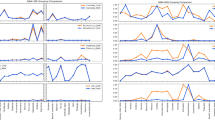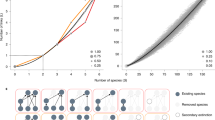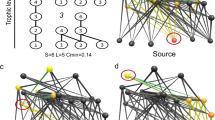Abstract
Compartments1 in food webs are subgroups of taxa in which many strong interactions occur within the subgroups and few weak interactions occur between the subgroups2. Theoretically, compartments increase the stability in networks1,2,3,4,5, such as food webs. Compartments have been difficult to detect in empirical food webs because of incompatible approaches6,7,8,9 or insufficient methodological rigour8,10,11. Here we show that a method for detecting compartments from the social networking science12,13,14 identified significant compartments in three of five complex, empirical food webs. Detection of compartments was influenced by food web resolution, such as interactions with weights. Because the method identifies compartmental boundaries in which interactions are concentrated, it is compatible with the definition of compartments. The method is rigorous because it maximizes an explicit function, identifies the number of non-overlapping compartments, assigns membership to compartments, and tests the statistical significance of the results12,13,14. A graphical presentation14 reveals systemic relationships and taxa-specific positions as structured by compartments. From this graphic, we explore two scenarios of disturbance to develop a hypothesis for testing how compartmentalized interactions increase stability in food webs15,16,17.
This is a preview of subscription content, access via your institution
Access options
Subscribe to this journal
Receive 51 print issues and online access
$199.00 per year
only $3.90 per issue
Buy this article
- Purchase on Springer Link
- Instant access to full article PDF
Prices may be subject to local taxes which are calculated during checkout

Similar content being viewed by others
References
Pimm, S. L. The structure of food webs. Theor. Popul. Biol. 16, 144–158 (1979)
May, R. M. Stability and Complexity in Model Ecosystems (Princeton Univ. Press, 1973)
Simon, H. A. in General Systems: Yearbook of the Society for General Systems (eds von Bertalanffy, L. & Rapaport, A.) Vol. 10 63–76 (Society for General Systems, Ann Arbor, Michigan, 1965)
McNaughton, S. J. Stability and diversity of ecological communities. Nature 274, 251–252 (1978)
Simmel, G. The Sociology of Georg Simmel (transl. and ed. Wolff, K. H.) (Free Press, Glencoe, Illinois, 1950)
Pimm, S. L. & Lawton, J. H. Are food webs divided into compartments? J. Anim. Ecol. 49, 879–898 (1980)
Yodiz, P. The compartmentation of real and assembled ecosystems. Am. Nat. 120, 551–570 (1982)
Raffaelli, D. & Hall, S. J. Compartments and predation in an estuarine food web. J. Anim. Ecol. 61, 551–560 (1992)
Dicks, L. V., Corbet, S. A. & Pywell, R. F. Compartmentalization in plant–insect flower visitor webs. J. Anim. Ecol. 71, 32–43 (2002)
Moore, J. C. & Hunt, H. W. Resource compartmentation and the stability of real ecosystems. Nature 333, 261–263 (1988)
Girvan, M. & Newman, M. E. J. Community structure in social and biological networks. Proc. Natl Acad. Sci. USA 99, 8271–8276 (2002)
Frank, K. Identifying cohesive subgroups. Soc. Networks 17, 27–56 (1995)
Frank, K. Mapping interactions within and between cohesive subgroups. Soc. Networks 18, 93–119 (1996)
Frank, K. & Yasumoto, J. Y. Linking action to social structure within a system: social capital within and between groups. Am. J. Sociol. 104, 642–686 (1998)
Grimm, V. A down-to-earth assessment of stability concepts in ecology: dreams, demands, and the real problems. Senckenbergiana maritima 27, 215–226 (1996)
McCann, K. S. The diversity–stability debate. Nature 405, 228–233 (2000)
Dunne, J. A., Williams, R. J. & Martinez, N. D. Network structure and biodiversity loss in food webs: robustness increases with connectance. Ecol. Lett. 5, 558–567 (2002)
Johnson, J. C., Borgatti, S. P., Luczkovich, J. J. & Everett, M. G. Network role analysis in the study of food webs: an application of regular role coloration. J. Soc. Structure 2; published online at 〈http://zeeb.library.cmu.edu:7850/JoSS/johnson/RoleAnalysis.html〉 (2001)
McMahon, S. M., Miller, K. H. & Drake, J. Networking tips for social scientists and ecologists. Science 293, 1604–1605 (2001)
Simmel, G. Conflict and the Web of Group Affiliations transl. Wolff, K. (Free Press, Glencoe, Illinois, 1955)
Blau, P. M. Inequality and Heterogeneity (Macmillan, New York, 1977)
Martinez, N. D. Artifacts or attributes? Effects of resolution on the Little Rock Lake food web. Ecol. Monogr. 61, 367–392 (1991)
Raffaelli, D. From Elton to mathematics and back again. Science 296, 1035–1037 (2002)
Huxham, M., Beaney, S. & Raffaelli, D. Do parasites reduce the chances of triangulation in a real food web? Oikos 76, 284–300 (1996)
Williams, R. J. & Martinez, N. D Simple rules yield complex food webs. Nature 404, 180–183 (2000)
Goldwasser, L. & Roughgarden, J. Construction and analysis of a large Caribbean food web. Ecology 74, 1216–1233 (1993)
Ulanowicz, R. E. & Baird, D. Nutrient controls on ecosystem dynamics: the Chesapeake mesohaline community. J. Mar. Syst. 19, 159–172 (1999)
Abarca-Arenas, L. G. & Ulanowicz, R. E. The effects of taxonomic aggregation on network analysis. Ecol. Modell. 149, 285–296 (2002)
Polis, G. A. Complex trophic interactions in deserts: an empirical critique of food-web theory. Am. Nat. 138, 123–155 (1991)
Neutel, A. M., Heesterneek, J. A. P. & de Ruiter, P. C. Stability in real food webs: weak links in long loops. Science 296, 1120–1123 (2002)
Acknowledgements
We thank M. Huxham and D. Raffaelli for providing data on the Ythan Estuary food web; N. Martinez and J. Dunne for providing data on the Little Rock Lake food webs; L. Abarca-Arenas for providing data on the 45-taxa Chesapeake Bay food web; C. Darnell for enhancing the diagram; and C. Goddard and J. Liu for comments and suggestions. This work was supported by the Great Lakes Fishery Commission (A.E.K., D.M.M.), the National Institute of Child Health and Human Development (K.A.F.) and the National Science Foundation (K.A.F.). Opinions reflect those of the authors and do not necessarily reflect those of the granting agency.
Author information
Authors and Affiliations
Corresponding author
Ethics declarations
Competing interests
The authors declare that they have no competing financial interests.
Rights and permissions
About this article
Cite this article
Krause, A., Frank, K., Mason, D. et al. Compartments revealed in food-web structure. Nature 426, 282–285 (2003). https://doi.org/10.1038/nature02115
Received:
Accepted:
Issue Date:
DOI: https://doi.org/10.1038/nature02115
This article is cited by
-
Species richness and network topology patterns in Neotropical plant-galling communities changes along an urbanization gradient
Journal of Insect Conservation (2024)
-
Enzymatically prepared alginate oligosaccharides improve broiler chicken growth performance by modulating the gut microbiota and growth hormone signals
Journal of Animal Science and Biotechnology (2023)
-
Composition, structure and robustness of Lichen guilds
Scientific Reports (2023)
-
Organic Matter Decomposition in River Ecosystems: Microbial Interactions Influenced by Total Nitrogen and Temperature in River Water
Microbial Ecology (2023)
-
Habitat types in the Atlantic Forest differently influence community structure and species interaction of cavity-nesting Hymenoptera and their natural enemies
Journal of Insect Conservation (2023)
Comments
By submitting a comment you agree to abide by our Terms and Community Guidelines. If you find something abusive or that does not comply with our terms or guidelines please flag it as inappropriate.



